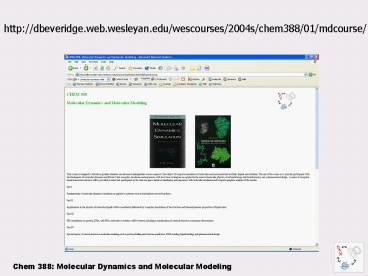http:dbeveridge.web.wesleyan.eduwescourses2004schem38801mdcourse PowerPoint PPT Presentation
1 / 32
Title: http:dbeveridge.web.wesleyan.eduwescourses2004schem38801mdcourse
1
http//dbeveridge.web.wesleyan.edu/wescourses/2004
s/chem388/01/mdcourse/
2
Introduction Chapter 1 Haile
- System
- Modeling vs. Simulation
- Models for molecular simulation
- Steps in Simulation
- Simulation Theory or experiment?
- Simulations Stochastic vs. Deterministic
3
What is a system?
- A system is
- A portion of the world on which to focus
attention - A subset of the universe (System Surrounding)
- Composed of any number of similar or dissimilar
parts (i.e. be homogeneous or heterogeneous)
4
- What is a state of the system?
- A specific conditions of all the parts
- What are the Observables of a system?
- Numerical values referring to a state or function
which are, in principle, measurable
experimentally - Eg. PV NkBT
5
State Variables
Extensive variable Scales linearly with system
size Intensive variable Conjugate field,
size-independent
Ensembles
EVN Microcanonical TPN Isothermal-isobaric TVN
Canonical TV? Grand-canonical
6
Modeling vs. Simulation
Studying a system involves
Manipulate and control certain observables
(inputs)
Measure or compute other observables (outputs)
System
Problem To define the state in such a way that
complicated interactions among state variables
are decoupled so that observable outputs can be
computed.
A model is simpler than the system it mimics.
A simulation is more complex than the system it
simulates.
7
Modeling vs. Simulation
- A model is a representation of the system,
conceptual or mathematical, which - Behaves like the system
- But involves fewer states
- i.e. some interactions of lesser importance are
neglected - A simulation is a numerical calculation of
properties of a model based on a trajectory. - Decompose interactions
- More constraints
8
Modeling vs. Simulation
9
Models for Molecular Simulation
Molecular Interactions
Simulated Model
Boundary Conditions
10
Steps in Simulation
- Model building
- Calculation of a trajectory
- Analysis of the trajectory
11
Hierarchy of Scientific modes of Investigation
System of Interest
Experiment
Theory
Simulation
Reductionism
Computer simulation
Mathematical models
Analytically Solvable
Computer simulation
Experiment
Theory
- Development of Models occurs as a result of
Reductionistic approach to a system.
12
Simulation Deterministic vs. Stochastic
Deterministic
Stochastic
Metropolis Monte Carlo
Force-Biased Monte Carlo
Brownian Dynamics
Langevin Dynamics
Molecular Dynamics
13
Assessment of a Simulation
- What are the possible sources of error or
uncertainty? - Are sampled populations representative?
- Are the results reproducible?
- Are the results internally consistent?
- Do the results confirm results from elsewhere?
14
Fundamentals Chapter 2 Haile
- Newtonian Dynamics
- Hamiltonian Dynamics
- Phase space
- Classification of Dynamical Systems
- Phase space Problem
- Stability of Trajectories
- Determination of Properties
- Sampling Theory
- Periodic Boundary Conditions
15
Newtonian Dynamics
- First Law
- A system will be at rest or moving at a specific
velocity until a force acts on it. - Second Law
- F ma
- Third Law
- Any force exerted by molecule 1 on molecule 2
must be balanced by a force exerted by 2 on 1
16
Hamiltonian Dynamics
Hamiltonian
17
Difference Between Newtonian and Hamiltonian
Dynamics
- Newtonian Dynamics considers forces explicitly
- Hamiltonian Dynamics conserves Hamiltonian
18
Phase-Space of 1-DHO
19
Phase Space
- A 6N dimensional hyper-surface composed of 3N
configuration space terms and 3N momentum space
terms
R. Penrose, The Emperors New Mind, OUP, NY 1989.
20
Classification of Dynamical Systems
21
Classification of Dynamical Systems
- Recurrent Trajectories
- For a phase space of finite volume, the phase
point will pass, arbitrarily closely and
indefinitely often, almost every accessible
configuration on the trajectory. - Non-Recurrent Trajectories
- Motion of most comets
22
Classification of Dynamical Systems
- Hamiltonian
- The trajectory is constrained in the phase space
to the hyper-surface of constant H - Non-Hamiltonian
- Eg Dissipative Systems
23
Classification of Dynamical Systems
- Integrable
- Number of constants of the motion equals the
number of degrees of freedom - E.g. I-DHO
- Non-Integrable
- Equation of motion has nonlinear terms
- E.g. Classic 3-body problem
24
Classification of Dynamical Systems
- Periodic
- Within a finite time, the phase trajectory will
intersect itself - Quasi-Periodic
- The phase-space trajectory is confined to the
surface of a torus. The torus is a subspace of
the constant-Hamiltonian surface.
25
Quasi-Periodic Motion
26
Classification of Dynamical Systems
27
Classification of Dynamical Systems
- Non-Ergodic
- Ergodic
- Over a sufficiently long time the phase point
passes through all configurations on the constant
Hamiltonian surface - Ergodicity does not guarantee that an isolated
system started from an arbitrary non-equilibrium
state will irreversibly evolve to equilibrium
states.
28
Stability of a Trajectory
29
Classification of Dynamical Systems Ability to
Evolve from Non-Equilibrium to Equilibrium States
- Mixing
- A perturbed trajectory must drift away from its
unperturbed parent trajectory, may be slow or
fast - K-Flow
- In response to a small perturbation, a K-flow
trajectory diverges exponentially - B-Flow
- The state observed at an instant on a perturbed
trajectory is completely uncorrelated with the
state on the parent trajectory
30
Classification of Dynamical Systems
31
Classification Summary
- Seven classes of Hamiltonian Dynamics are not
mutually exclusive - High levels of instability encompass the
desirable properties of lower levels - In MD simulations, the equations of motion are
non-integrable and the computed trajectories are
recurrent, Hamiltonian, at least mixing and
preferably K-flows.
32
Meta-Stable States

